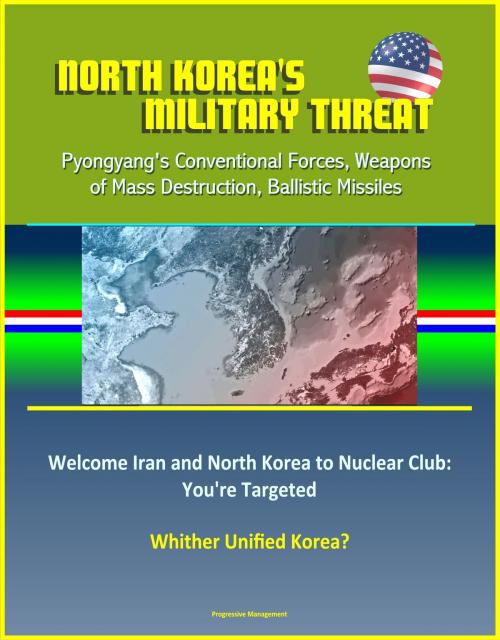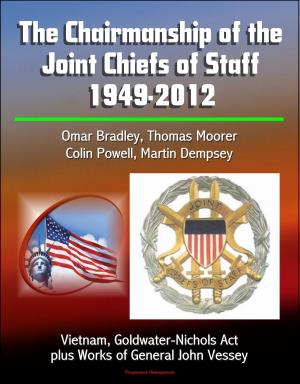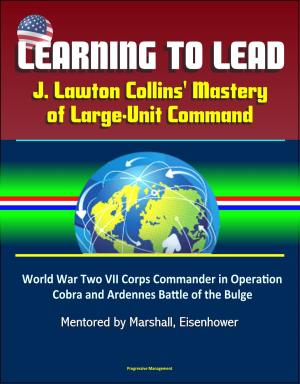North Korea's Military Threat: Pyongyang's Conventional Forces, Weapons of Mass Destruction, Ballistic Missiles; Welcome Iran and North Korea to Nuclear Club: You're Targeted; Whither Unified Korea?
Nonfiction, History, Military, Nuclear Warfare, Middle East| Author: | Progressive Management | ISBN: | 9781370144419 |
| Publisher: | Progressive Management | Publication: | March 31, 2017 |
| Imprint: | Smashwords Edition | Language: | English |
| Author: | Progressive Management |
| ISBN: | 9781370144419 |
| Publisher: | Progressive Management |
| Publication: | March 31, 2017 |
| Imprint: | Smashwords Edition |
| Language: | English |
These excellent reports have been professionally converted for accurate flowing-text e-book format reproduction: North Korea's Military Threat: Pyongyang's Conventional Forces, Weapons Of Mass Destruction, and Ballistic Missiles; Welcome Iran and North Korea to the Nuclear Club: You're Targeted; Whither Unified Korea? East, West or Center?
North Korea's Military Threat: Pyongyang's Conventional Forces, Weapons Of Mass Destruction, and Ballistic Missiles - North Korea is a country of paradoxes and contradictions. Although it remains an economic basket case that cannot feed and clothe its own people, it nevertheless possesses one of the world's largest armed forces. Whether measured in terms of the total number of personnel in uniform, numbers of special operations soldiers, the size of its submarine fleet, quantity of ballistic missiles in its arsenal, or its substantial weapons of mass destruction programs, Pyongyang is a major military power. North Korea's latest act to demonstrate its might was the seismic event on October 9, 2006. In addition to sizeable conventional forces, North Korea has significant WMD and ballistic missile programs. Nuclear weapons almost certainly were on Kim Il Sung's mind from 1945 onward. He was impressed by the power of the bombs used on Hiroshima and Nagasaki, both in terms of their destructive capacity and their value as a political weapon. The DPRK's quest for a nuclear program began in the 1950s. Pyongyang has multiple reasons for keeping the program and no obvious good or compelling reasons to give it up.
Welcome Iran and North Korea to the Nuclear Club: You're Targeted - In one of the great ironies of the post-Cold War era, the United States, the most powerful nuclear state in the world, seems fear stricken by the possibility of Iran and North Korea obtaining nuclear weapons. Two facts frame the dilemma: both states are intent on becoming nuclear powers, and neither the European Union (EU) nor China is willing to help curb their ambitions. Clearly, nonproliferation is an important policy goal, but the United States should not view leakage as a catastrophe. Rather, the proper response is a declaratory policy of nuclear deterrence directed specifically at Iran and North Korea once they become nuclear powers. As scholars and practitioners long have affirmed, the essence of nuclear deterrence is the certitude that an attack with nuclear weapons will result in a retaliatory strike of assured destruction. The idea is to make the consequences so severe that the nuclear option is never contemplated. U.S. nuclear credibility rests on both the capability and the national will to retaliate with nuclear weapons.
Whither Unified Korea? East, West or Center? Since the end of the Korean War, the balance of power in Northeast Asia has been significantly shaped by an enduring Republic of Korea (ROK)-US alliance. Despite the constant threat of a resumption of hostilities between the two Koreas, the current structure maintains a status quo that assures the balance of power in Northeast Asia. However, if hostilities or a collapse of the Democratic Republic of North Korea (DPRK) lead to a unified Korea; its choice of alignment could disrupt the balance of power imposed on the region since 1953. A unified Korea's profound and strategic decision of alignment will not come easy and will not be black or white. It will however have the potential to shift the regional balance of power—a decision influenced by Korean history, culture, nationalism and the interests of the regional stakeholders. A unified Korea has three broadly defined alignment options—tilt West towards the United States and Japan, tilt East towards the People's Republic of China (PRC), or pursue neutrality/nonalignment, each with their own advantages, disadvantages, and nuanced variations.
These excellent reports have been professionally converted for accurate flowing-text e-book format reproduction: North Korea's Military Threat: Pyongyang's Conventional Forces, Weapons Of Mass Destruction, and Ballistic Missiles; Welcome Iran and North Korea to the Nuclear Club: You're Targeted; Whither Unified Korea? East, West or Center?
North Korea's Military Threat: Pyongyang's Conventional Forces, Weapons Of Mass Destruction, and Ballistic Missiles - North Korea is a country of paradoxes and contradictions. Although it remains an economic basket case that cannot feed and clothe its own people, it nevertheless possesses one of the world's largest armed forces. Whether measured in terms of the total number of personnel in uniform, numbers of special operations soldiers, the size of its submarine fleet, quantity of ballistic missiles in its arsenal, or its substantial weapons of mass destruction programs, Pyongyang is a major military power. North Korea's latest act to demonstrate its might was the seismic event on October 9, 2006. In addition to sizeable conventional forces, North Korea has significant WMD and ballistic missile programs. Nuclear weapons almost certainly were on Kim Il Sung's mind from 1945 onward. He was impressed by the power of the bombs used on Hiroshima and Nagasaki, both in terms of their destructive capacity and their value as a political weapon. The DPRK's quest for a nuclear program began in the 1950s. Pyongyang has multiple reasons for keeping the program and no obvious good or compelling reasons to give it up.
Welcome Iran and North Korea to the Nuclear Club: You're Targeted - In one of the great ironies of the post-Cold War era, the United States, the most powerful nuclear state in the world, seems fear stricken by the possibility of Iran and North Korea obtaining nuclear weapons. Two facts frame the dilemma: both states are intent on becoming nuclear powers, and neither the European Union (EU) nor China is willing to help curb their ambitions. Clearly, nonproliferation is an important policy goal, but the United States should not view leakage as a catastrophe. Rather, the proper response is a declaratory policy of nuclear deterrence directed specifically at Iran and North Korea once they become nuclear powers. As scholars and practitioners long have affirmed, the essence of nuclear deterrence is the certitude that an attack with nuclear weapons will result in a retaliatory strike of assured destruction. The idea is to make the consequences so severe that the nuclear option is never contemplated. U.S. nuclear credibility rests on both the capability and the national will to retaliate with nuclear weapons.
Whither Unified Korea? East, West or Center? Since the end of the Korean War, the balance of power in Northeast Asia has been significantly shaped by an enduring Republic of Korea (ROK)-US alliance. Despite the constant threat of a resumption of hostilities between the two Koreas, the current structure maintains a status quo that assures the balance of power in Northeast Asia. However, if hostilities or a collapse of the Democratic Republic of North Korea (DPRK) lead to a unified Korea; its choice of alignment could disrupt the balance of power imposed on the region since 1953. A unified Korea's profound and strategic decision of alignment will not come easy and will not be black or white. It will however have the potential to shift the regional balance of power—a decision influenced by Korean history, culture, nationalism and the interests of the regional stakeholders. A unified Korea has three broadly defined alignment options—tilt West towards the United States and Japan, tilt East towards the People's Republic of China (PRC), or pursue neutrality/nonalignment, each with their own advantages, disadvantages, and nuanced variations.















